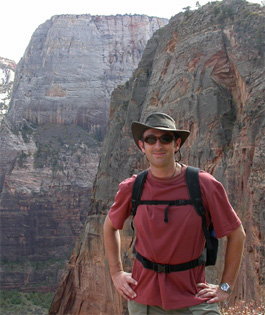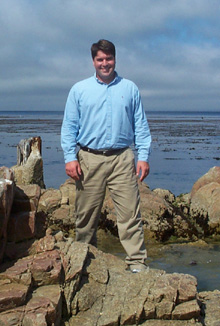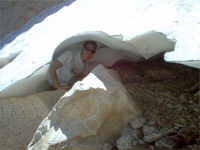 |
|||||
|
Internships and Volunteer Programs MBNMS Award Winners and Honorees
|
| MBNMS Research & Monitoring Staff | |||
 Andrew
DeVogelaere, Ph.D.
Andrew
DeVogelaere, Ph.D.
Research Coordinator/SIMoN Program Director
(831) 647-4213
andrew.devogelaere@noaa.gov
Dr. DeVogelaere oversees the Sanctuary's Research
Program. This includes facilitating collaboration among over 20 research
institutions in the region, providing technical information to decision
makers and the Sanctuary staff, and initiating research on resource management
issues. Dr. DeVogelaere is also leading the effort to develop the Sanctuary
Integrated Monitoring Network (SIMoN), a critical program that assesses
how populations of marine organisms and habitats are changing through
time.
He has been directly involved in a wide variety of research projects,
ranging in habitats from the deep sea to estuaries. His past work experience
includes being an elected official as Commissioner for the Moss Landing
Harbor District and Research Coordinator for the Elkhorn Slough National
Estuarine Research Reserve. He earned a Bachelor of Arts degree in Biology
from the University of California at Berkeley, a Master of Science degree
in Marine Science from Moss Landing Marine Laboratories, and a Doctorate
degree in Biology from the University of California at Santa Cruz.
 Erica
J. Burton
Erica
J. Burton
Research Specialist
(831) 647-4246
erica.burton@noaa.gov
As a Research Specialist, Erica Burton works on marine research issues such as ecosystem characterization, marine reserves, fisheries, and submerged cultural resources. She also spends time at sea collecting scientific data and information. Several projects include characterization of the Davidson Seamount, monitoring and characterization of deep-water fish and invertebrate assemblages, and biological characterizations at shipwreck sites. Erica also provides programatic support to the Research Activity Panel, and on the evaluation of MBNMS research permits.
Erica earned a Bachelor of Science Degree in Marine Biology at Long Beach State University, and a Master of Science Degree in Marine Science at Moss Landing Marine Laboratories. Her graduate research focused on age, longevity, and growth determination of fishes, including radiometric age determination of the giant grenadier, bocaccio rockfish, Atlantic tarpon, and Atlantic sturgeon.
 Jean de Marignac
Jean de MarignacField Scientist
(831) 647-4214
jean.demarignac@noaa.gov
Jean has been part of the Research Team since 2003. His responsibilities include developing collaborations with regional scientists to share monitoring data, and interpreting monitoring trends. He is actively involved with the field research operations of the Sanctuary, including video characterization and monitoring of the continental shelf, beach cast seabirds and marine mammals surveys, and damage assessment.
Jean earned a Bachelor of Arts in Human Ecology from College of the Atlantic and a Master of Science in Marine Science from Moss Landing Marine Laboratories. He is an avid naturalist. His undergraduate and graduate research focused on the ecology and life history of the lemon shark in Bimini, Bahamas. However, his research interests are not limited to shark. His experience also includes aging the pink surfperch, surveying and photo-identifying marine mammals, and tagging and measuring oxygen consumption of tunas. He also conducted underwater surveys aboard the Delta, a small submersible, to describe essential fish habitat and compare ground fish abundance, size, and distribution inside and outside the Big Creek Ecological Reserve in California. Jean is an enthusiastic traveler. In 2000, he traveled around the world with his wife for a year and that incredible adventure reinforced his desire to have a career that combines marine science, conservation and education.
 Steve I. Lonhart, Ph.D.
Steve I. Lonhart, Ph.D.
SIMoN Senior Scientist
(831) 420-3661
steve.lonhart@noaa.gov
As one of the scientists for the Sanctuary Integrated Monitoring Network (SIMoN), Steve is responsible for developing SIMoN's research and monitoring program. The scientific goals of SIMoN are to: (1) integrate existing monitoring programs within the Sanctuary; (2) initiate new monitoring programs to address important gaps of knowledge; and (3) disseminate monitoring data in a timely fashion to resource managers, researchers, educators, and the general public.
Steve has a Bachelor of Science in Biology from UCLA, a Master of Science in Biology from California State University Long Beach, and a Doctorate in Biology from UC Santa Cruz. Though he has several interests in marine ecology, his scientific research has focused on invasion biology, kelp forest ecology, and marine invertebrate natural history, with an emphasis on marine gastropods.
 Chad King
Chad King
SIMoN Data Analyst
(831) 647-4248
chad.king@noaa.gov
As
the Data Analyses Specialist, Chad King is responsible for the collection,
analyses and dissemination of spatial data for the Sanctuary
Integrated Monitoring Network (SIMoN). These data help integrate past and present
monitoring programs within the Sanctuary, provide resource managers with
decision making tools, and will be available to researchers, educators,
students and the general public. He is also an active participant in
the field with the MBNMS Research and SIMoN teams.
Chad earned a Bachelor of Science Degree in Marine Biology at the University
of California, Santa Cruz, and a Master of Science Degree in Marine Science
from Moss Landing Marine Laboratories. His research focus was on how
genetics of an algal symbiont and substratum instability affect the reproductive
behavior of a sea anemone from the Gulf of Mexico. Previous research
focused on kelp forest ecology. Prior to SIMoN, he was with the California
Department of Fish and Game as a GIS Analyst. His work there primarily
addressed spatial analyses of commercial fishing pressure and the correlation
between rugosity of the sea floor and rockfish abundance. This included
the coordination of high-resolution map development of the sea floor,
GPS navigation, and rockfish counts using SCUBA.
 Scott Chapman
Scott Chapman
SIMoN Web Developer
(831) 420-3660
scott.chapman@noaa.gov
Scott works with the technical infrastructure of the Sanctuary Integrated Monitoring Network (SIMoN). Using cutting-edge web technology, he is responsible for building and maintaining the SIMoN website, interfaces used to enter and manage monitoring information, and the SIMoN database.
Upon earning a Bachelor of Science in Electrical Engineering from San Jose State University, Scott worked as a software and quality assurance engineer for various software companies in Silicon Valley. Much of his development work utilized the latest web technologies to deliver interactive and dynamic content over the internet.
Scott is also a SCUBA instructor and has an MA in Exercise Physiology. He spent four summers at the Monterey Bay Aquarium teaching kids basic SCUBA skills and educating them about local marine life. Along with his work with SIMoN, Scott currently teaches a number of fitness and SCUBA-related courses at a local community college.
 Gary Conley
Gary Conley
Water Quality Data Analyst
(831) 420-3663
gary.conley@noaa.gov
As a member of the Sanctuary Integrated Monitoring Network (SIMoN) team, Gary is conducting an assessment of water quality in the Monterey Bay National Marine Sanctuary and its watersheds. He coordinates with monitoring organizations on the central coast, synthesizing and analyzing data sets to address non-point-source pollution problems. Gary works to understand how pollutant levels in our waters are changing over space and time with the goals of improving regional monitoring/data management strategies and identifying relationships between pollutant levels and land management practices.
Gary earned a Bachelor of Science in Earth Sciences from UC Santa Cruz and a Master of Science degree in Geography from San Diego State University. His scientific research has focused on numerical modeling of hydrologic systems, spatial analysis, and quantifying environmental changes using satellite observations.
 Jennifer Brown. Ph.D.
Jennifer Brown. Ph.D.
SIMoN Ecosystem Scientist
(415) 310-6764
jennifer.brown@noaa.gov
As the Ecosystem Scientist for the Sanctuary Integrated Monitoring Network (SIMoN), Jennifer Brown is responsible for developing and coordinating ecosystem assessments at both local and regional levels. These ecosystem models and condition reports help address resource management needs for integrated monitoring information. Additionally, Jennifer provides science support for the Marine Protected Areas MBNMS Action Plan through the development of data summaries and resource assessments.
Jennifer has a Bachelor of Science Degree in Biology from University of California at Los Angeles and a Doctorate Degree in Ecology and Evolutionary Biology from the University of California at Santa Cruz. Her research focused on evaluating the relative value of nearshore ecosystems at nursery grounds for juvenile flatfish. Other past projects focused on the Monterey Bay area include: 1) A Review of Marine Zones in the Monterey Bay National Marine Sanctuary which is part of the National Marine Sanctuary Conservation Series, 2) A plan for monitoring the fish assemblage in Elkhorn Slough prepared for the Elkhorn Slough National Research Reserve, and 3) a review of the Special Status Species that reside in or transit through the Monterey Bay National Marine Sanctuary.
 Steve Choy
Steve Choy
Sea Grant Fellow
(831) 647-4228
steve.choy@noaa.gov
Steve recently joined the research team as a Sea Grant Fellow. While he has not yet solidified a project to work on for the coming year, he is excited to continue his work with the Marine Sanctuaries Program. He has spent the last two years interning with the Channel Islands National Marine Sanctuary while attending graduate school. He completed a GIS mapping project of research activities occuring in Sanctuary waters, as well as an analysis of CDFG patrol activity.
Steve received is BS in Biology with a minor in Chemistry from the University of Illinois at Urbana-Champaign. After graduating, he enrolled at the University of California's Donald Bren School of Environmental Science and Management, where he specialized in Coastal Marine Resources Management and Conservation Planning. His Group Project Thesis examined the benefits of integrating the commercial and recreational fishing sectors of Southern California's Nearshore Fishery.
| National
Marine Sanctuaries | National
Ocean Service | National Oceanic
and Atmospheric Administration U.S. Department of Commerce | NOAA Library |
||
|
|
||
 |
For Website comments/questions, contact the MBNMS Webmaster. For programmatic comments/question, contact the appropriate MBNMS Staff. MBNMS Privacy Statement This page last modified on: 11/06/08 |
 |
|
|
||
| URL: http://montereybay.noaa.gov/intro/aboutoffice/researchstaff.html | ||